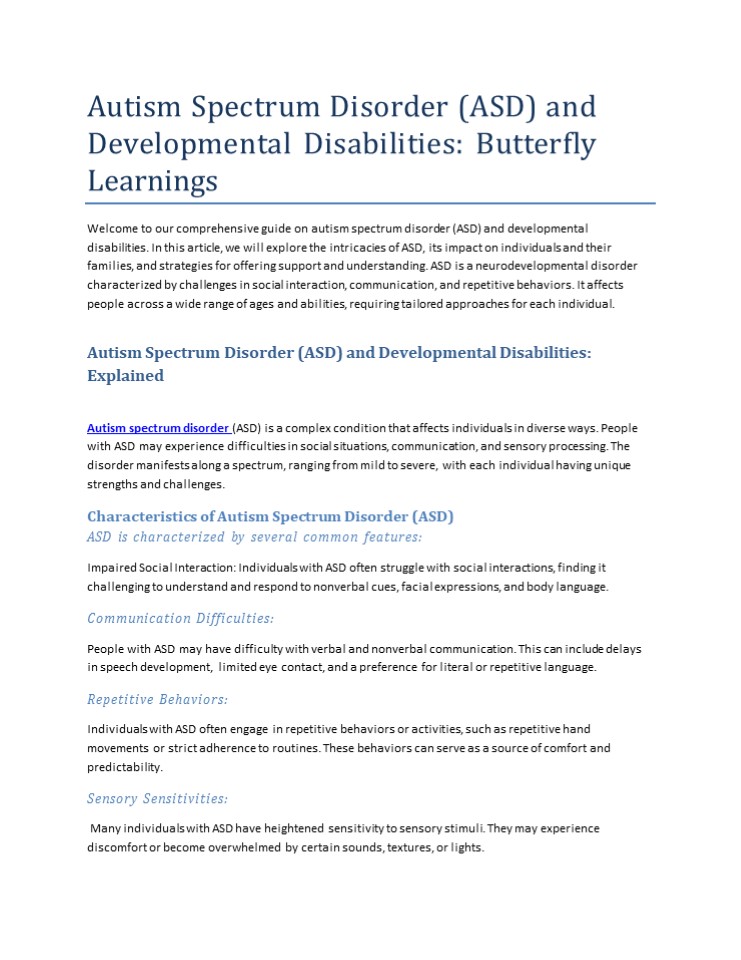Autism Spectrum Disorder (ASD) and Developmental Disabilities: Butterfly Learnings - PowerPoint PPT Presentation
Title:
Autism Spectrum Disorder (ASD) and Developmental Disabilities: Butterfly Learnings
Description:
Butterfly Learnings provide you with a thorough understanding of autism, its various aspects, and the challenges faced by individuals with autism spectrum disorder (ASD) and developmental disabilities. – PowerPoint PPT presentation
Number of Views:1
Title: Autism Spectrum Disorder (ASD) and Developmental Disabilities: Butterfly Learnings
1
Autism Spectrum Disorder (ASD) and Developmental
Disabilities Butterfly Learnings
Welcome to our comprehensive guide on autism
spectrum disorder (ASD) and developmental
disabilities. In this article, we will explore
the intricacies of ASD, its impact on individuals
and their families, and strategies for offering
support and understanding. ASD is a
neurodevelopmental disorder characterized by
challenges in social interaction, communication,
and repetitive behaviors. It affects people
across a wide range of ages and abilities,
requiring tailored approaches for each
individual. Autism Spectrum Disorder (ASD) and
Developmental Disabilities Explained Autism
spectrum disorder (ASD) is a complex condition
that affects individuals in diverse ways. People
with ASD may experience difficulties in social
situations, communication, and sensory
processing. The disorder manifests along a
spectrum, ranging from mild to severe, with each
individual having unique strengths and
challenges. Characteristics of Autism Spectrum
Disorder (ASD) ASD is characterized by several
common features Impaired Social Interaction
Individuals with ASD often struggle with social
interactions, finding it challenging to
understand and respond to nonverbal cues, facial
expressions, and body language. Communication
Difficulties People with ASD may have difficulty
with verbal and nonverbal communication. This can
include delays in speech development, limited
eye contact, and a preference for literal or
repetitive language. Repetitive
Behaviors Individuals with ASD often engage in
repetitive behaviors or activities, such as
repetitive hand movements or strict adherence to
routines. These behaviors can serve as a source
of comfort and predictability. Sensory
Sensitivities Many individuals with ASD have
heightened sensitivity to sensory stimuli. They
may experience discomfort or become overwhelmed
by certain sounds, textures, or lights.
2
- FAQs about Autism Spectrum Disorder (ASD) and
Developmental Disabilities - What causes autism spectrum disorder ( ASD)?
- ASD is a complex disorder with no singular cause.
Research suggests a combination of genetic and
environmental factors contribute to its
development. It is important to note that
vaccines do not cause autism. - How early can autism spectrum disorder (ASD) be
diagnosed? - ASD can be diagnosed as early as 18 months, but
it is often identified around the age of 2 or 3
when noticeable developmental delays become
apparent. - Are all individuals with autism nonverbal?
- No, not all individuals with autism are
nonverbal. While some may experience speech
delays or difficulties, others develop language
skills within the typical range. - Is there a cure for autism spectrum disorder
(ASD)? - Currently, there is no known cure for ASD.
However, early intervention, therapy, and support
services can greatly improve quality of life and
help individuals with ASD reach their full
potential. - How can I support someone with autism spectrum
disorder ( ASD)? - Supporting someone with ASD involves
understanding and accommodating their unique
needs. Providing clear communication, creating
structured routines, and offering
sensory-friendly environments are valuable
strategies. - Are there any famous individuals with autism
spectrum disorder (ASD)? - Yes, several famous individuals have openly
shared their experiences with ASD, including
Temple Grandin, an accomplished animal scientist
and autism advocate. - Strategies for Supporting Individuals with Autism
Spectrum Disorder (ASD) Supporting individuals
with ASD requires a multifaceted approach,
tailored to their specific strengths and
challenges. Here are some strategies for creating
a supportive environment
3
Clear and concise communication is vital when
interacting with individuals with ASD. Use simple
language, visual aids, and gestures to enhance
understanding. Give them time to process
information and avoid ambiguous or figurative
language.
- Establish Predictable Routines
- Routine and predictability can provide a sense of
security for individuals with ASD. Create
structured schedules and stick to them as much
as possible. Prepare them in advance for any
changes or transitions. - Encourage Social Skills Development
- Social skills can be challenging for individuals
with ASD, but they can be developed with practice
and support. Encourage social interactions,
provide opportunities for socializing, and teach
specific social cues and skills through
role-playing and modeling. - Offer Individualized Educational Support
- Individualized education plans (IEPs) can help
tailor educational strategies to meet the unique
needs of students with ASD. Collaboration
between educators, therapists, and families is
crucial for creating effective learning
environments. - Foster Inclusion and Acceptance
- Promote acceptance and inclusion of individuals
with ASD in schools, workplaces, and communities.
Encourage empathy and educate others about ASD
to reduce stigma and create a supportive society. - Butterfly Learnings provide you with a thorough
understanding of autism, its various aspects, and
the challenges faced by individuals with autism
spectrum disorder (ASD) and developmental
disabilities. - Understanding autism spectrum disorder (ASD) and
developmental disabilities is crucial for
providing effective support and fostering
inclusivity. By recognizing the unique challenges
individuals with ASD face, we can create
environments that celebrate their strengths and
empower them to reach their full potential.
Through patience, empathy, and tailored
strategies, we can collectively work towards a
more inclusive and accepting world for
individuals with ASD and developmental
disabilities.































